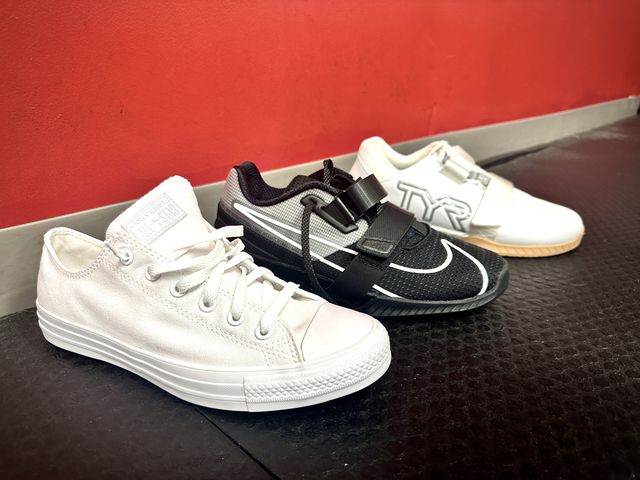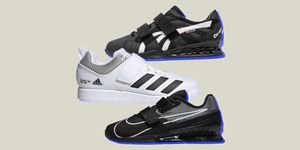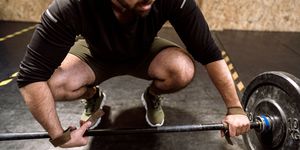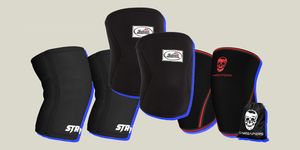Investing in a pair of weightlifting shoes can be a great way to upgrade your strength training setup. Instead of your normal gym sneakers that fare well across multiple exercises, these kicks are more fine-tuned for those movements where max effort is almost a must, including the back squat, deadlift, snatch and clean and jerk. Plus, having sneakers solely designed for a given exercise can give you some extra motivation to push yourself toward new personal bests. After all, what’s the sense in having the tools if you don’t use them to their full advantage?
If you peruse the internet long enough in your search for worthwhile weightlifting shoes, you’re likely to see three silhouettes more often than not: Nike’s Romaleos 4s, TYR’s L-1 Lifters and the classic Converse Chuck Taylor All Stars. These three sneakers have proven to be reputable additions to any gym bag, but with two similar silhouettes and one completely out of left field, how is an unknowing athlete to determine which shoes are right for their needs?
Now, I’m no stranger to these three weightlifting shoe profiles and have used each respectively in my efforts to chase down PRs in the four exercises listed above. In my opinion, there’s room for them all in a training shoe rotation, but I understand that not everyone is as psychotically infatuated with keeping a lengthy footwear roster for the sake of training. So, to see which weightlifting shoe could give you the most muscle-building potential, I donned all three across multiple in-gym sessions, noting where each shined brightest underfoot.
Nike Romaleos 4 Vs. TYR L-1 Lifter Vs. Converse Chuck Taylor: What We Think
If you’re comparing these three weightlifting silhouettes and had to go with one, I would recommend the Romaleos 4s from Nike. The lockdown is plenty sturdy, the stability under heavy squats or Olympic lifts is immaculate, and the heavy-set build keeps you grounded for those heavy pulls.
With that said, though, keeping the Romaleos 4s on throughout an entire workout can leave your dogs barking, thanks to a narrower toe box. If you want a similar performance experience with some added room for comfort (and don’t want to mess around with Nike’s sizing), the TYR L-1 Lifters may be your more reasonable pick.
Now, when it comes to the Chuck Taylors, the 0mm heel-to-toe drop puts all the emphasis on your strength levels, which can be good or bad depending on your goals. You’d be pushing yourself more in training, but there’s no elevated heel to help you achieve your highest totals possible. At less than $100, though, I’d still recommend keeping a pair on standby, even if you only break them out for deadlifts.
The Nike Romaleos 4s practically glue you to the lifting platform.
You don’t want your feet sliding out from under you in the throws of a heavy squat or snatch, so having a shoe that keeps your position secured is a must. While I appreciate the traction underfoot with the L-1s and Chuck Taylors, it’s hard to ignore the locked-in feel you get with Nike’s Romaleos 4s. The outsole is plenty tacky for grip across hardwood, plywood and other gym flooring options, and the sheer weight of the shoe itself is enough to pin you down without fail. I think this stability is best examined when vaulting a clean and jerk overhead — there’s no sliding or sense of missteps when you go to catch and brace.
There’s also a heightened sense of stability underfoot thanks to the Romaleos 4s’s rigid and flared heel design. Pushing out of the hole during squats is a breeze as there’s no cushioning to fight through, and the raised 20mm heel-to-toe drop is excellent for keeping your form throughout the movement. Naturally, squatting in Converses does have you fight through the midsole more, and there’s no heel elevation to help facilitate a deeper squat. The TYR L-1s are comparable and pose a good comparison, but I felt the Nike offerings created a more rigid setup ever so slightly.
TYR and Converse make a more comfortable shoe for extended wear.
Another reason I prefer the Nike Romaleos 4s over other weightlifting shoes is the snug fit that encapsulates your foot. There’s no budging or room for errant movement, which is great for preventing sliding or missteps during dynamic exercises. With that said, though, keeping your feet constricted in these clogs for extended periods of time can begin to wear on you. If you’re like me, your heavy lifts are usually toward the front of your training session, so that means you have two options — trudge back to the locker room to put on your normal gym shoes, or bear the snugness and aches for the remainder of your workout.
The L-1s and Chuck Taylors, on the other hand, did not provide an irritating fit once my training made its way to machines and accessory exercises. The TYRs feature a wider toe box that allows the toe to splay, which can be a nice perk for static lifts and creating that grounded sensation. When not moving intense weight, that extra room allows your feet to rest comfortably within. For Converse fans, the canvas upper has enough flexibility to keep you comfortable, albeit without much structure for excessive lockdown.
You can achieve a more comfortable fit with the Romaleos 4s if you adjust your chosen size (these have been known to run small in past iterations), but if you want coziness straight out of the box, both TYRs and Converses have you covered.
It's hard to top the Chuck Taylor's performance during deadlifts.
It might seem like the Converse Chuck Taylor All Star has no right to be compared with TYR and Nike weightlifting shoes since there’s less lockdown across the top of the foot and no elevated heel to help with squatting motions. Well, the tables get completely turned in Chuck’s favor when you approach a deadlift bar. That flat outsole and grippy traction is perfect for achieving ground contact. Yes, I’ve had success in deadlifting with the Romaleos 4s and L-1 Lifters, respectively, but the forward-flung setup is less comfortable than my positioning when wearing Chucks, and I often feel like my knees are too far over the bar during the start of my pull.
Another perk to the Converse Chuck Taylors is their price, naturally. If you really wanted to match your footwear to your lifts for the best results possible, you could always opt for one clog design and keep your Chucks in tote solely for deadlift days. They pack away discreetly thanks to the canvas makeup, and two shoes for less than $300 is a fair deal, in my opinion. You can also have your Converses pull double duty as a training and lifestyle shoe, although it’s not the best practice overall.
Nike Romaleos 4 Vs. TYR L-1 Lifter Vs. Converse Chuck Taylor: Alternatives
If you’re looking for other options in terms of weightlifting shoes, you have a few silhouettes to choose from. For example, Reebok’s Legacy Lifter III profile is an ideal pick for Olympic lifting enthusiasts thanks to a higher heel-to-toe drop, but the narrow midfoot has been known to be an irritating sensation for some. On the powerlifting side, Adidas’s Powerlift 5 silhouette is a good solution that’s also more affordable, but the lockdown isn’t on par with Nike or TYR since there’s a single strap rather than two.
For athletes wanting an alternative to Chuck Taylors, you can’t go wrong with a pair of Authentic Vans. Like Chucks, these zero-drop kicks have their roots in athletics, but have taken on a more lifestyle aesthetic over the years. Their affordability is top notch, too, in comparison to other gym shoes, but you may find that the underfoot cushioning is a little too much to achieve that grounded feel.































